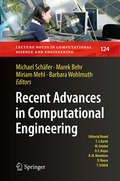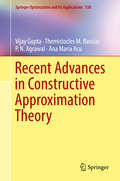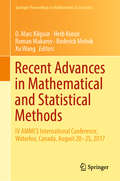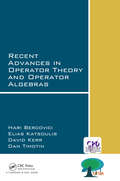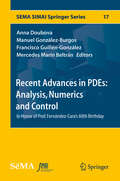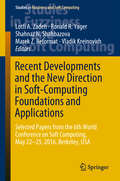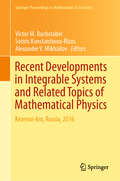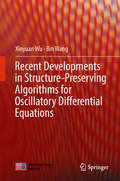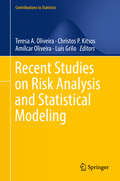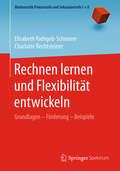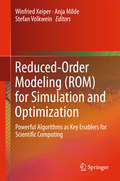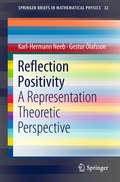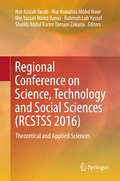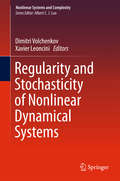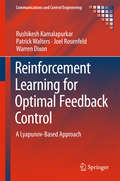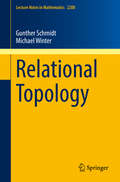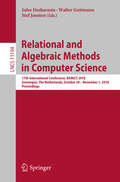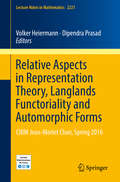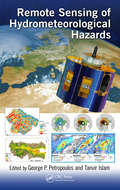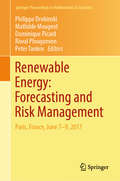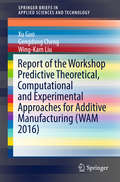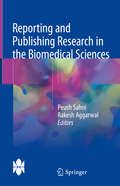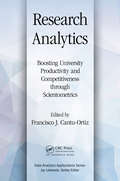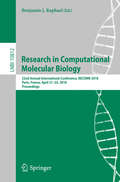- Table View
- List View
Recent Advances in Computational Engineering: Proceedings of the 4th International Conference on Computational Engineering (ICCE 2017) in Darmstadt (Lecture Notes in Computational Science and Engineering #124)
by Michael Schäfer Miriam Mehl Marek Behr Barbara WohlmuthThis book comprises the proceedings of the 4th International Conference on Computational Engineering (ICCE 2017), held in Darmstadt, Germany on September 28-29, 2017. The conference is intended to provide an interdisciplinary meeting place for researchers and practitioners working on computational methods in all disciplines of engineering, applied mathematics and computer science. The aims of the conference are to discuss the state of the art in this challenging field, exchange experiences, develop promising perspectives for future research and initiate further cooperation.Computational Engineering is a modern and multidisciplinary science for computer-based modeling, simulation, analysis, and optimization of complex engineering applications and natural phenomena. The book contains an overview of selected approaches from numerics and optimization of Partial Differential Equations as well as uncertainty quantification techniques, typically in multiphysics environments. Where possible, application cases from engineering are integrated.The book will be of interest to researchers and practitioners of Computational Engineering, Applied Mathematics, Engineering Sciences and Computer Science.
Recent Advances in Constructive Approximation Theory (Springer Optimization and Its Applications #138)
by Vijay Gupta Themistocles M. Rassias P. N. Agrawal Ana Maria AcuThis book presents an in-depth study on advances in constructive approximation theory with recent problems on linear positive operators. State-of-the-art research in constructive approximation is treated with extensions to approximation results on linear positive operators in a post quantum and bivariate setting. Methods, techniques, and problems in approximation theory are demonstrated with applications to optimization, physics, and biology. Graduate students, research scientists and engineers working in mathematics, physics, and industry will broaden their understanding of operators essential to pure and applied mathematics. Topics discussed include: discrete operators, quantitative estimates, post-quantum calculus, integral operators, univariate Gruss-type inequalities for positive linear operators, bivariate operators of discrete and integral type, convergence of GBS operators.
Recent Advances in Information and Communication Technology 2017
by Phayung Meesad Herwig Unger Sunantha SodseeThis book includes selected contributions related to big data and data networking, presented at the 13th International Conference on Computing and Information Technology (IC2IT), which was held at the Arnoma Grand Hotel Bangkok, Thailand, July 6-7, 2017. The aim of the conference was to present emerging algorithms, methods and technologies with a high degree of originality, novelty and innovation addressing the conference theme `Mastering Data and Networking'. Section 1 and 2 discuss various aspects of data mining and corresponding applications. Section 3 focuses on speed and overhead networking optimisation problems, as well as energy problems of autonomous systems, which are becoming increasingly important. The key to addressing these problems is properly determining critical parameters. Section 4 sheds light on natural language processing, including extraction of trends and popularity and recognition of emotions as well as classic topics such as detection and classification.
Recent Advances in Mathematical and Statistical Methods: Iv Ammcs International Conference, Waterloo, Canada, August 20-25 2017 (Springer Proceedings in Mathematics & Statistics #259)
by Roderick Melnik D. Marc Kilgour Herb Kunze Roman Makarov Xu WangThis book focuses on the recent development of methodologies and computation methods in mathematical and statistical modelling, computational science and applied mathematics. It emphasizes the development of theories and applications, and promotes interdisciplinary endeavour among mathematicians, statisticians, scientists, engineers and researchers from other disciplines. The book provides ideas, methods and tools in mathematical and statistical modelling that have been developed for a wide range of research fields, including medical, health sciences, biology, environmental science, engineering, physics and chemistry, finance, economics and social sciences. It presents original results addressing real-world problems. The contributions are products of a highly successful meeting held in August 2017 on the main campus of Wilfrid Laurier University, in Waterloo, Canada, the International Conference on Applied Mathematics, Modeling and Computational Science (AMMCS-2017). They make this book a valuable resource for readers interested not only in a broader overview of the methods, ideas and tools in mathematical and statistical approaches, but also in how they can attain valuable insights into problems arising in other disciplines.
Recent Advances in Operator Theory and Operator Algebras: Xixth International Conference On Operator Theory, Timisoara (romania) 2002 (Operator Theory: Advances And Applications Ser. #153)
by David Kerr Hari Bercovici Elias Katsoulis Dan TimotinThis book will contain lectures given by four eminent speakers at the Recent Advances in Operator Theory and Operator Algebras conference held at the Indian Statistical Institute, Bangalore, India in 2014. The main aim of this book is to bring together various results in one place with cogent introduction and references for further study.
Recent Advances in PDEs: In Honor Of Prof. Fernández-cara's 60th Birthday (SEMA SIMAI Springer Series #17)
by Anna Doubova Manuel González-Burgos Francisco Guillén-González Mercedes Marín BeltránThis book contains the main results of the talks given at the workshop “Recent Advances in PDEs: Analysis, Numerics and Control”, which took place in Sevilla (Spain) on January 25-27, 2017. The work comprises 12 contributions given by high-level researchers in the partial differential equation (PDE) area to celebrate the 60th anniversary of Enrique Fernández-Cara (University of Sevilla). The main topics covered here are: Control and inverse problems, Analysis of Fluid mechanics and Numerical Analysis. The work is devoted to researchers in these fields.
Recent Developments and the New Direction in Soft-Computing Foundations and Applications: Selected Papers From The 6th World Conference On Soft Computing, May 22-25, 2016, Berkeley, Usa (Studies in Fuzziness and Soft Computing #361)
by Lotfi A. Zadeh Ronald R. Yager Marek Z. Reformat Vladik Kreinovich Shahnaz N. ShahbazovaThis book is an authoritative collection of contributions in the field of soft-computing. Based on selected works presented at the 6th World Conference on Soft Computing, held on May 22-25, 2016, in Berkeley, USA, it describes new theoretical advances, as well as cutting-edge methods and applications. Theories cover a wealth of topics, such as fuzzy logic, cognitive modeling, Bayesian and probabilistic methods, multi-criteria decision making, utility theory, approximate reasoning, human-centric computing and many others. Applications concerns a number of fields, such as internet and semantic web, social networks and trust, control and robotics, computer vision, medicine and bioinformatics, as well as finance, security and e-Commerce, among others. Dedicated to the 50th Anniversary of Fuzzy Logic and to the 95th Birthday Anniversary of Lotfi A. Zadeh, the book not only offers a timely view on the field, yet it also discusses thought-provoking developments and challenges, thus fostering new research directions in the diverse areas of soft computing.
Recent Developments in Integrable Systems and Related Topics of Mathematical Physics: Kezenoi-am, Russia 2016 (Springer Proceedings in Mathematics & Statistics #273)
by Victor M. Buchstaber Sotiris Konstantinou-Rizos Alexander V. MikhailovThis volume, whose contributors include leading researchers in their field, covers a wide range of topics surrounding Integrable Systems, from theoretical developments to applications. Comprising a unique collection of research articles and surveys, the book aims to serve as a bridge between the various areas of Mathematics related to Integrable Systems and Mathematical Physics. <P><P>Recommended for postgraduate students and early career researchers who aim to acquire knowledge in this area in preparation for further research, this book is also suitable for established researchers aiming to get up to speed with recent developments in the area, and may very well be used as a guide for further study.
Recent Developments in Structure-Preserving Algorithms for Oscillatory Differential Equations
by Bin Wang Xinyuan WuThe main theme of this book is recent progress in structure-preserving algorithms for solving initial value problems of oscillatory differential equations arising in a variety of research areas, such as astronomy, theoretical physics, electronics, quantum mechanics and engineering. It systematically describes the latest advances in the development of structure-preserving integrators for oscillatory differential equations, such as structure-preserving exponential integrators, functionally fitted energy-preserving integrators, exponential Fourier collocation methods, trigonometric collocation methods, and symmetric and arbitrarily high-order time-stepping methods. Most of the material presented here is drawn from the recent literature. Theoretical analysis of the newly developed schemes shows their advantages in the context of structure preservation. All the new methods introduced in this book are proven to be highly effective compared with the well-known codes in the scientific literature. This book also addresses challenging problems at the forefront of modern numerical analysis and presents a wide range of modern tools and techniques.
Recent Studies on Risk Analysis and Statistical Modeling (Contributions to Statistics)
by Christos P. Kitsos Teresa A. Oliveira Amílcar Oliveira Luís GriloThis book provides an overview of the latest developments in the field of risk analysis (RA). Statistical methodologies have long-since been employed as crucial decision support tools in RA. Thus, in the context of this new century, characterized by a variety of daily risks - from security to health risks - the importance of exploring theoretical and applied issues connecting RA and statistical modeling (SM) is self-evident. In addition to discussing the latest methodological advances in these areas, the book explores applications in a broad range of settings, such as medicine, biology, insurance, pharmacology and agriculture, while also fostering applications in newly emerging areas. This book is intended for graduate students as well as quantitative researchers in the area of RA.
Rechnen lernen und Flexibilität entwickeln
by Elisabeth Rathgeb-Schnierer Charlotte RechtsteinerDieser Band thematisiert vielseitig und aspektreich das flexible Rechnen in der Grundschule. Die Notwendigkeit der Förderung flexibler Rechenkompetenzen im Mathematikunterricht der Grundschule ist unumstritten und über die Zielrichtung des Mathematiklernens besteht Konsens: Kinder sollen bei der Ablösung des zählenden Rechnens begleitet und zum flexiblen Rechnen herausgefordert werden. Was bedeutet dies aber konkret? Was verstehen wir unter flexiblem Rechnen und wie kann flexibles Rechnen im Sinne eines kumulativen Aufbaus über die gesamte Grundschulzeit bei Kindern mit verschiedenen Lernvoraussetzungen gefördert werden? Diesen Fragen wird im Buch nachgegangen: Im Vordergrund steht dabei das Ziel, die Thematik einerseits theoretisch detailliert aufzuarbeiten, andererseits sie im Hinblick auf Unterricht zu konkretisieren. Die theoretische Aufarbeitung beschäftigt sich zunächst mit dem Prozess des Rechnens und darauf aufbauend allgemein mit Überlegungen zum Rechnenlernen und zur Entwicklung von Flexibilität. Die unterrichtspraktischen Aktivitäten im Rahmen der Zahlenblickschulung beziehen sich vorwiegend auf die Klassen 1 bis 3, da der Schwerpunkt des flexiblen Rechnens im Bereich des Zahlenrechnens im Zahlenraum bis 1000 liegt. Zielgruppen dieses Buches sind sowohl Studierende, Referendare und Referendarinnen als auch Lehrerinnen und Lehrer der Primarstufe.
Reduced-Order Modeling (ROM) for Simulation and Optimization
by Winfried Keiper Anja Milde Stefan VolkweinThis edited monograph collects research contributions and addresses the advancement of efficient numerical procedures in the area of model order reduction (MOR) for simulation, optimization and control. The topical scope includes, but is not limited to, new out-of-the-box algorithmic solutions for scientific computing, e.g. reduced basis methods for industrial problems and MOR approaches for electrochemical processes. The target audience comprises research experts and practitioners in the field of simulation, optimization and control, but the book may also be beneficial for graduate students alike.
Reflection Positivity: A Representation Theoretic Perspective (SpringerBriefs in Mathematical Physics #32)
by Karl-Hermann Neeb Gestur ÓlafssonRefection Positivity is a central theme at the crossroads of Lie group representations, euclidean and abstract harmonic analysis, constructive quantum field theory, and stochastic processes.This book provides the first presentation of the representation theoretic aspects of Refection Positivity and discusses its connections to those different fields on a level suitable for doctoral students and researchers in related fields.It starts with a general introduction to the ideas and methods involving refection positive Hilbert spaces and the Osterwalder--Schrader transform. It then turns to Reflection Positivity in Lie group representations. Already the case of one-dimensional groups is extremely rich.For the real line it connects naturally with Lax--Phillips scattering theory and for the circle group it provides a new perspective on the Kubo--Martin--Schwinger (KMS) condition for states of operator algebras. For Lie groups Reflection Positivity connects unitary representations of a symmetric Lie group with unitary representations of its Cartan dual Lie group.A typical example is the duality between the Euclidean group E(n) and the Poincare group P(n) of special relativity. It discusses in particular the curved context of the duality between spheres and hyperbolic spaces. Further it presents some new integration techniques for representations of Lie algebras by unbounded operators which are needed for the passage to the dual group. Positive definite functions, kernels and distributions and used throughout as a central tool.
Regional Conference on Science, Technology and Social Sciences: Theoretical And Applied Sciences (RCSTSS #2016)
by Nor Azizah Yacob Nur Asmaliza Mohd Noor Nor Yuziah Mohd Yunus Rahmah Lob Yussof Shaikh Abdul Karim Yamani ZakariaThis book gathers selected theoretical and applied science papers presented at the 2016 Regional Conference of Sciences, Technology and Social Sciences (RCSTSS 2016), organized biannually by the Universiti Teknologi MARA Pahang, Malaysia. Addressing a broad range of topics, including architecture, computer science, engineering, environmental and management, furniture, forestry, health and medicine, material science, mathematics, plantation and agrotechnology, sports science and statistics, the book serves as an essential platform for disseminating research findings, and inspires positive innovations in the region’s development.The carefully reviewed papers in this volume present work by researchers of local, regional and global prominence. Taken together, they offer a valuable reference guide and point of departure for all academics and students who want to pursue further research in their respective fields.
Regularity and Stochasticity of Nonlinear Dynamical Systems
by Dimitri Volchenkov Xavier LeonciniThis book presents recent developments in nonlinear dynamics and physics with an emphasis on complex systems. The contributors provide recent theoretic developments and new techniques to solve nonlinear dynamical systems and help readers understand complexity, stochasticity, and regularity in nonlinear dynamical systems. This book covers integro-differential equation solvability, Poincare recurrences in ergodic systems, orientable horseshoe structure, analytical routes of periodic motions to chaos, grazing on impulsive differential equations, from chaos to order in coupled oscillators, and differential-invariant solutions for automorphic systems, inequality under uncertainty.
Reinforcement Learning for Optimal Feedback Control: A Lyapunov-based Approach (Communications and Control Engineering)
by Patrick Walters Joel Rosenfeld Rushikesh Kamalapurkar Warren DixonReinforcement Learning for Optimal Feedback Control develops model-based and data-driven reinforcement learning methods for solving optimal control problems in nonlinear deterministic dynamical systems. In order to achieve learning under uncertainty, data-driven methods for identifying system models in real-time are also developed. The book illustrates the advantages gained from the use of a model and the use of previous experience in the form of recorded data through simulations and experiments. The book’s focus on deterministic systems allows for an in-depth Lyapunov-based analysis of the performance of the methods described during the learning phase and during execution. To yield an approximate optimal controller, the authors focus on theories and methods that fall under the umbrella of actor–critic methods for machine learning. They concentrate on establishing stability during the learning phase and the execution phase, and adaptive model-based and data-driven reinforcement learning, to assist readers in the learning process, which typically relies on instantaneous input-output measurements. This monograph provides academic researchers with backgrounds in diverse disciplines from aerospace engineering to computer science, who are interested in optimal reinforcement learning functional analysis and functional approximation theory, with a good introduction to the use of model-based methods. The thorough treatment of an advanced treatment to control will also interest practitioners working in the chemical-process and power-supply industry.
Relational Topology (Lecture Notes in Mathematics #2208)
by Michael Winter Gunther SchmidtThis book introduces and develops new algebraic methods to work with relations, often conceived as Boolean matrices, and applies them to topology. Although these objects mirror the matrices that appear throughout mathematics, numerics, statistics, engineering, and elsewhere, the methods used to work with them are much less well known. In addition to their purely topological applications, the volume also details how the techniques may be successfully applied to spatial reasoning and to logics of computer science. Topologists will find several familiar concepts presented in a concise and algebraically manipulable form which is far more condensed than usual, but visualized via represented relations and thus readily graspable. This approach also offers the possibility of handling topological problems using proof assistants.
Relational and Algebraic Methods in Computer Science: 17th International Conference, RAMiCS 2018, Groningen, The Netherlands, October 29 – November 1, 2018, Proceedings (Lecture Notes in Computer Science #11194)
by Jules Desharnais Walter Guttmann Stef JoostenThis book constitutes the proceedings of the 17th International Conference on Relational and Algebraic Methods in Computer Science, RAMiCS 2018, held in Groningen, The Netherlands, in October/November 2018. The 21 full papers and 1 invited paper presented together with 2 invited abstracts and 1 abstract of a tutorial were carefully selected from 31 submissions. The papers are organized in the following topics: Theoretical foundations; reasoning about computations and programs; and applications and tools.
Relative Aspects in Representation Theory, Langlands Functoriality and Automorphic Forms: CIRM Jean-Morlet Chair, Spring 2016 (Lecture Notes in Mathematics #2221)
by Volker Heiermann Dipendra PrasadThis volume presents a panorama of the diverse activities organized by V. Heiermann and D. Prasad in Marseille at the CIRM for the Chaire Morlet event during the first semester of 2016. It assembles together expository articles on topics which previously could only be found in research papers. Starting with a very detailed article by P. Baumann and S. Riche on the geometric Satake correspondence, the book continues with three introductory articles on distinguished representations due to P. Broussous, F. Murnaghan, and O. Offen; an expository article of I. Badulescu on the Jacquet–Langlands correspondence; a paper of J. Arthur on functoriality and the trace formula in the context of "Beyond Endoscopy", taken from the Simons Proceedings; an article of W-W. Li attempting to generalize Godement–Jacquet theory; and a research paper of C. Moeglin and D. Renard, applying the trace formula to the local Langlands classification for classical groups. The book should be of interest to students as well as professional researchers working in the broad area of number theory and representation theory.
Remote Sensing of Hydrometeorological Hazards
by Tanvir Islam George P. PetropoulosExtreme weather and climate change aggravate the frequency and magnitude of disasters. Facing atypical and more severe events, existing early warning and response systems become inadequate both in scale and scope. Earth Observation (EO) provides today information at global, regional and even basin scales related to agrometeorological hazards. This book focuses on drought, flood, frost, landslides, and storms/cyclones and covers different applications of EO data used from prediction to mapping damages as well as recovery for each category. It explains the added value of EO technology in comparison with conventional techniques applied today through many case studies.
Renewable Energy: Paris, France, June 7-9, 2017 (Springer Proceedings in Mathematics & Statistics #254)
by Philippe Drobinski Mathilde Mougeot Dominique Picard Riwal Plougonven Peter TankovGathering selected, revised and extended contributions from the conference ‘Forecasting and Risk Management for Renewable Energy FOREWER’, which took place in Paris in June 2017, this book focuses on the applications of statistics to the risk management and forecasting problems arising in the renewable energy industry. The different contributions explore all aspects of the energy production chain: forecasting and probabilistic modelling of renewable resources, including probabilistic forecasting approaches; modelling and forecasting of wind and solar power production; prediction of electricity demand; optimal operation of microgrids involving renewable production; and finally the effect of renewable production on electricity market prices. Written by experts in statistics, probability, risk management, economics and electrical engineering, this multidisciplinary volume will serve as a reference on renewable energy risk management and at the same time as a source of inspiration for statisticians and probabilists aiming to work on energy-related problems.
Report of the Workshop Predictive Theoretical, Computational and Experimental Approaches for Additive Manufacturing (WAM #2016)
by Xu Guo Gengdong Cheng Wing-Kam LiuThe volume focuses on theoretical and computational approaches and involves areas such as simulation-based engineering and science, integrated computational materials engineering, mechanics, material science, manufacturing processes, and other specialized areas. Most importantly, the state-of-the-art progress in developing predictive theoretical, computational and experimental approaches for additive manufacturing is summarized.
Reporting and Publishing Research in the Biomedical Sciences: Revised Edition
by Peush Sahni Rakesh AggarwalThis book eases the task of converting research work into a manuscript, and covers the recent developments in publishing that often stump budding researchers.Few researchers in the biomedical sciences are trained in the essential skills of reporting their results, and they seek help in writing a paper that will be acceptable for publication in the ‘right’ journal, and in presenting their results ‘effectively’ at a meeting. As well as covering the basic aspects of preparing manuscripts for publication, the book discusses best practices and issues relating to the publication of biomedical research, including topics such as peer-review, authorship, plagiarism, conflicts of interest, publication misconduct, electronic publishing and open-access journals. With more than two decades of experience in conducting workshops on writing scientific papers, the editors have brought together the expertise of 29 authors from seven countries to produce this one-stop guide to publishing research in biomedical sciences. This book is intended for young researchers who are beginning their careers and wish to hone their skills and understand the rigors of research writing and publishing.
Research Analytics: Boosting University Productivity and Competitiveness through Scientometrics (Data Analytics Applications)
by Francisco J. Cantu-OrtizThe growth of machines and users of the Internet has led to the proliferation of all sorts of data concerning individuals, institutions, companies, governments, universities, and all kinds of known objects and events happening everywhere in daily life. Scientific knowledge is not an exception to the data boom. The phenomenon of data growth in science pushes forth as the number of scientific papers published doubles every 9–15 years, and the need for methods and tools to understand what is reported in scientific literature becomes evident. <P><P>As the number of academicians and innovators swells, so do the number of publications of all types, yielding outlets of documents and depots of authors and institutions that need to be found in Bibliometric databases. These databases are dug into and treated to hand over metrics of research performance by means of Scientometrics that analyze the toil of individuals, institutions, journals, countries, and even regions of the world. The objective of this book is to assist students, professors, university managers, government, industry, and stakeholders in general, understand which are the main Bibliometric databases, what are the key research indicators, and who are the main players in university rankings and the methodologies and approaches that they employ in producing ranking tables. <P><P>The book is divided into two sections. The first looks at Scientometric databases, including Scopus and Google Scholar as well as institutional repositories. The second section examines the application of Scientometrics to world-class universities and the role that Scientometrics can play in competition among them. It looks at university rankings and the methodologies used to create these rankings. Individual chapters examine specific rankings that include: <P><P> <P><P>QS World University <P><P>Scimago Institutions <P><P>Webometrics <P><P>U-Multirank <P><P>U.S. News & World Report <P><P>The book concludes with a discussion of university performance in the age of research analytics.
Research in Computational Molecular Biology: 22nd Annual International Conference, RECOMB 2018, Paris, France, April 21-24, 2018, Proceedings (Lecture Notes in Computer Science #10812)
by Benjamin J. RaphaelThis book constitutes the proceedings of the 22nd Annual Conference on Research in Computational Molecular Biology, RECOMB 2018, held in Paris, France, in April 2018.The 16 extended and 22 short abstracts presented were carefully reviewed and selected from 193 submissions. The short abstracts are included in the back matter of the volume. They report on original research in all areas of computational molecular biology and bioinformatics.
